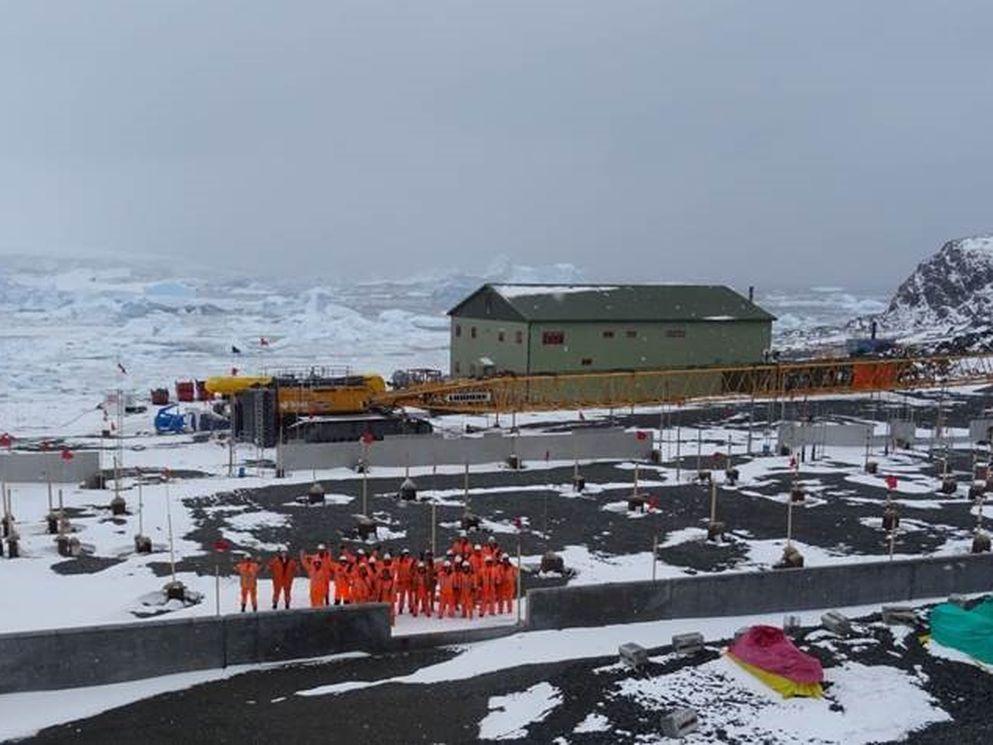Antarctic science hub takes shape amid complex construction season

(News release British Antarctic Survey:) London, 19 March 2021 - A specialist construction team is making the 11,000 km journey home to the UK after successfully completing the groundworks for a new state-of-the-art polar research building at British Antarctic Survey’s (BAS) Rothera Research Station, Antarctica.
Foundations for the new scientific support facility, the Discovery Building, were laid and perimeter wall erected this construction season. The new energy-efficient facility will support polar scientists who undertake vital research into climate change and biodiversity. The Discovery Building is part of a major programme commissioned by UKRI-NERC to modernise the UK’s Antarctic Infrastructure.
Delivering the new energy-efficient building is the Antarctic Infrastructure Modernisation Programme (AIMP) partnership, which includes construction partner BAM and their team – design consultants Sweco, and Hugh Broughton Architects providing delivery design. Ramboll is acting as British Antarctic Survey’s Technical Advisors, with their team – architects NORR providing concept design and Turner & Townsend providing cost management. The partnership encompasses a range of suppliers and subcontractors providing exceptional knowledge, materials and equipment to execute remarkable results in extreme conditions.
The coronavirus pandemic presented major logistical challenges. Construction can only take place during the Antarctic summer months between December to May because of harsh winter conditions. As a result of logistical constraints from the Covid-19 pandemic, the 24-person construction team had just ten weeks to complete this season’s work. The team also spent two weeks in quarantine before departing the UK and starting their journey to Antarctica by ship in late November.
The construction team was able to lay 70 precast concrete foundations to support the building’s structural steel frame and install the 32 sections of perimeter wall. The team have placed approximately 3,500 tonnes of graded rock fill to create the formation level, ready for the ground floor slabs to be fitted next season.
The Discovery Building replaces six old buildings at the station and is expected to be completed in 2024. The new two-storey 4,500 m² (gross internal area) facility has energy saving features, including thermally-efficient building envelope, heat recovery generators and thermal stores, and a ventilation system with air exchanges based on occupancy. The Discovery Building will use some renewable energy, including photovoltaic solar panels. To minimise snow accumulation around the entire perimeter of the building, it features a slight pitched roof and wind deflector, the largest of it’s kind in Antarctica.
The unique design of the building will cater for the wellbeing and collaboration aspects of living in Antarctica. Vibrant, open-plan offices have been designed to foster better collaboration bringing natural light in during the long, dark Antarctic winters.
Jonathan Ager, Director of AIMP at British Antarctic Survey, said: ‘This has been the most challenging year for the programme since its inception in 2017. We were forced to curtail this activity last season, to bring our team home safely as the world entered lockdown. It was therefore essential that we completed the groundworks this season so that when we return in December we have the best opportunity to complete a weathertight structure, and to prevent damage from the extreme Antarctic winter. Alongside our industry partners and wider supply chain, we can’t wait to return in a few months to start work on this vital polar building.’
Martin Bellamy, Managing Director, at BAM said: ‘This is the end of a relatively short, but hugely successful season for the project and the team. Everyone in the partnership has worked brilliantly to deliver the work. The modernisation of the infrastructure in Antarctica is a true collaboration between science and industry. I’d like to thank everyone for the support and commitment during what has been a challenging time, globally.’
Bruce Wulff, Project Director at Ramboll, said: ‘The Discovery Building is a one of a kind and pushes the boundaries of design in extreme Antarctic conditions. It also makes a significant contribution towards BAS’s objectives of reducing its carbon emissions and it’s great to see it starting to take shape.’
Stewart Craigie, Technical Director at Sweco, said: ‘The close collaboration between owners, operators, constructors and designers has ensured the success of this project especially in this most challenging season with the reduced timeframe. It has been a privilege to play a small part in the team that have prepared the ground and set the foundations for the future seasons. We are definitely in a strong position to maintain our planned completion in 2024 and the team should be very proud of their achievements to date.’
Read more about the long-term Antarctic Infrastructure Modernisation Programme. The programme aims to keep the UK at the forefront of climate, biodiversity and ocean research.
About British Antarctic Survey:
British Antarctic Survey (BAS), an institute of the Natural Environment Research Council (UKRI-NERC)*, delivers and enables world-leading interdisciplinary research in the Polar Regions. Its skilled science and support staff based in Cambridge, Antarctica and the Arctic, work together to deliver research that uses the Polar Regions to advance our understanding of Earth and our impact on it.
Through its extensive logistic capability and know-how BAS facilitates access for the British and international science community to the UK polar research operation. Numerous national and international collaborations, combined with an excellent infrastructure, help sustain a world-leading position for the UK in Antarctic affairs. The UK is one of over thirty countries operating scientific research facilities in Antarctica. More information: www.bas.ac.uk/
*NERC is part of UK Research and Innovation
About BAM Nuttall
Along with BAM Construct in the UK, and BAM Contractors in Ireland, BAM Nuttall is part of Royal BAM Group. BAMâ¯delivers exceptional engineering, design, construction, property management, and investment services. The Group, turnover £7 billion annually, is listed on Euronext, Amsterdam.
BAM Nuttall, employing approximately 3,000 people, has a worldwide reputation for collaborating with clients, creating sustainable environments that enhance people’s lives. Our projects span the UK, and we’re involved in international partnerships including Africa, Australia and Antarctica. BAM people capitalise their knowledge, across multiple sectors including rail, marine, tunnelling, highways, energy, and water – using state-of-the-art resources and digital technologies to provide innovative solutions.
About Ramboll
Ramboll is a leading engineering, design and consultancy company founded in Denmark in 1945. The company employs more than 16,500 people globally and has especially strong representation in the Nordics, UK, North America, Continental Europe, Middle East and Asia-Pacific.
With 300 offices in 35 countries, Ramboll combines local experience with a global knowledgebase constantly striving to achieve inspiring and exacting solutions that make a genuine difference to our clients, the end-users, and society at large. Ramboll works across the following markets: Buildings, Transport, Planning & Urban Design, Water, Environment & Health, Energy and Management Consulting. More information is available at www.ramboll.com and www.ramboll.co.uk Follow us on LinkedIn and Twitter.
About Sweco
Sweco plans and designs the sustainable communities and cities of the future. Together with our clients and the collective knowledge of our 17,500 architects, engineers and other specialists, we co-create solutions to address urbanisation, capture the power of digitalisation, and make our societies more sustainable. Sweco is Europe’s leading engineering and architecture consultancy, with sales of approximately SEK 21 billion (EUR 2 billion). The company is listed on Nasdaq Stockholm. In the UK and Ireland, Sweco offers engineering, design and regulatory services.
About Hugh Broughton Architects
Hugh Broughton Architects was formed in 1996 and has a reputation for producing carefully crafted contemporary architecture. The practice is best known for the design of Halley VI Antarctic Research Station designed for the British Antarctic Survey with AECOM, which was officially launched in 2013 to great critical acclaim. In addition to the firm’s work on the Discovery Building as part of the British Antarctic Survey’s Antarctic Infrastructure Modernisation Programme partnership with BAM and Sweco, it has also led to a series of other projects in Antarctica including Juan Carlos 1 Spanish Antarctic Base, which opened in 2019; the redevelopment of Scott Base for Antarctica New Zealand, which the practice won in partnership with Jasmax in 2018; and the masterplan for Davis Station for the Australian Antarctic Division, which is being delivered with WSP.
About NORR
NORR is an employee-owned global architecture and engineering firm that has set the standard for inspired and timeless designs around the world. With offices in Canada, the US, UK and UAE, the firm employs more than 700 professionals in 14 diverse market sectors. Founded in 1938, we offer the stability of a rich history, the power of integrated global teams and the versatility of a proven, multi-sector portfolio. We’re architects, engineers, planners, interior designers, and big picture thinkers that apply our integrated thinking to drive exceptional projects for our clients. More information is available at norr.com or follow us on Linked In.
About Turner and Townsend
Turner & Townsend is an independent professional services company specialising in programme management, project management, cost and commercial management and advisory across the real estate, infrastructure and natural resources sectors. With 110 offices in 45 countries, it draws on extensive global and industry experience to manage risk while maximising value and performance during the construction and operation of clients’ assets.
Click here for the original press release.


